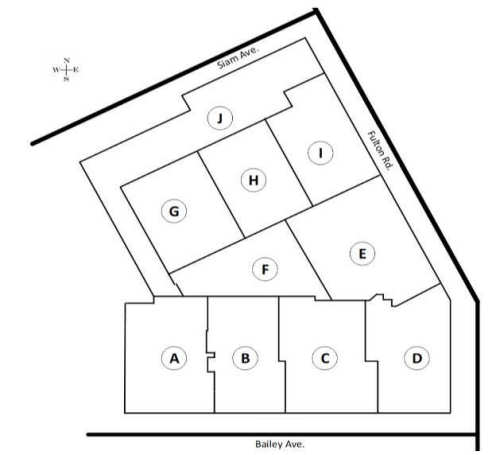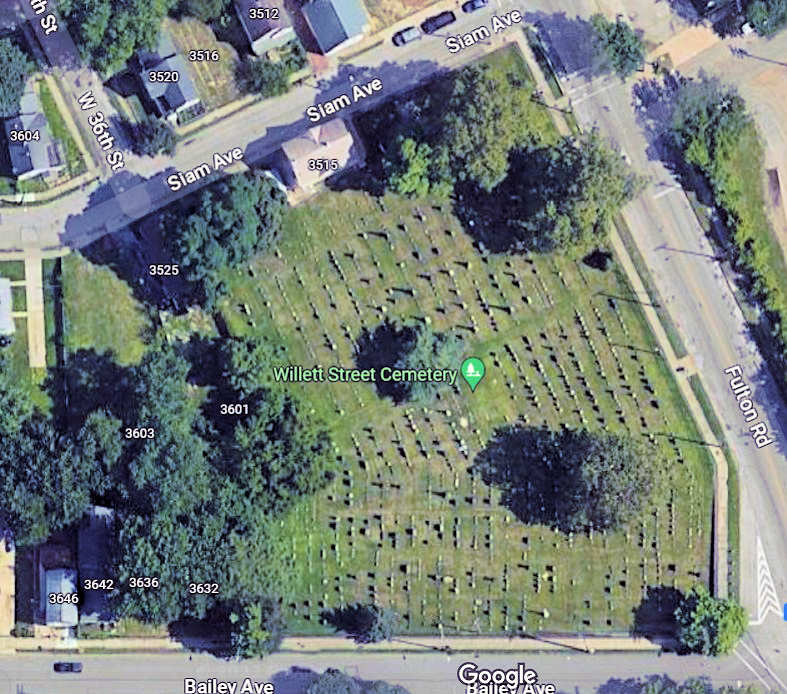|
Willet Street Cemetery - 1840 1,500+
burials (sometimes "Willett")
Cleveland's first Jewish cemetery.
|
|
 |
|
On April 1, 1840, the Israelitic Society,
formed soon after
the Alsbacher party of 15
arrived from Unsleben, Bavaria in August 1839, petitioned Cleveland City Council for a half-acre section of the Erie (East 9th)
Street Cemetery. City Council said 'no'. City law allowed only the sale of
family plots.
Read the story of that
failed petition.
Some time in July 1840 the Israelitic Society arranged to buy an acre of
land in Brooklyn Township on the west side
of the Cuyahoga River for $100 from Josiah
Barber.
On August 7,
1840, a Friday morning, the day before Tisha
B'Av, the most tragic day of the Jewish calendar,
Josiah Barber's deed of sale for one acre on Willet
Street in Old Brooklyn for $100 to the Israelitic
Society was recorded.
See the deed of
sale on our pages.
That afternoon the first
Jewish burial took place. It was Alexander
Kahnweiler, a recent immigrant from Bavaria who had
died peddling in a rural area.
The Israelitic Society soon became Anshe Chesed
congregation.
On April 20, 1854
Tifereth Israel, founded in 1850 with many of its
members having left Anshe Chesed, showed how strong
were the bonds of kinship and friendship among
Jewish Clevelanders when it bought its burial ground
next to Anshe Chesed's. It was one-third of an acre
south of Anshe Chesed's land from Joel Scranton
for $100. In 1871 and 1881 it
added small adjacent parcels. In the drawing below,
sections E - J were owned by Anshe Chesed. A - D by
Tifereth Israel.
|
|
 |
|
below: Google
Satellite View
 |
|
The cemetery is
north of I-90, where Fulton Road (once Willet Street) and Monroe Avenue intersect. The address is 2254 Fulton Road
in Cleveland.
Though headstones will be found here for burials as late as
the 1950s, there are many empty
spaces. They are the result of the removal of graves
to Mayfield Cemetery, for reburial among children
and grandchildren. Examples include
Simpson
and Regina Thorman
and
Moses and Yetta Alsbacher
and their daughter Julia.
Since 1890 Willet
Street Cemetery and Mayfield Cemetery have
been
owned and
maintained by
United Jewish Cemeteries,
an association now owned by Congregation Mishkan Or,
formed on July 1, 2024 by the unification of
Congregations Tifereth Israel
and Anshe Chesed.
The website
www.MayfieldCemetery.org includes an informative
History timeline
For access to
the cemetery, call (216) 321-1733, the office at Mayfield
Cemetery.
|
|
Who
was the seller, Josiah Barber?
Josiah Barber
(1771-1842) and his partner in real estate development Richard
Lord, owned the land along the lake west of the Cuyahoga River.
They were son-in-law and son of Samuel P Lord, an investor in
the Connecticut Land Company.
Barber had another
brother-in-law Leonard Eckstein Case Sr. who had also married a
daughter of Samuel Lord. Case managed the sales of the land east
of the Cuyahoga River. In 1843 he would make the
Great Gift to the
Jews of Cleveland — land for their first synagogue.
|
|
Why buy on the west side?
To our pioneer Jews, who lived where Progressive Field
stands today, near the Cuyahoga River, the near west side did
not seem far away. It was about two
miles away ─ a 40-minute walk or 20 minutes on a horse-drawn
wagon.
To cross the river they
probably used the Columbus Street Bridge, a toll bridge built in 1836.
For them, cemeteries were always outside
the town. Cost,
alone, would have ruled out a nearby burial ground. Their acre
on Willet Street in Brooklyn cost $100. An acre
in the city would have cost $3,000.
Is
it spelled Willet or Willett?
Jeffrey Morris, chronicler of our cemeteries, notes that
early maps and deeds spell the name
both ways. City
Council Archives say it was Willett.
We
prefer Willet, the spelling
used by United
Jewish Cemeteries and also found in the deeds of sale
from Josiah Barber in 1840 and Joel
Scranton in 1854. |
|